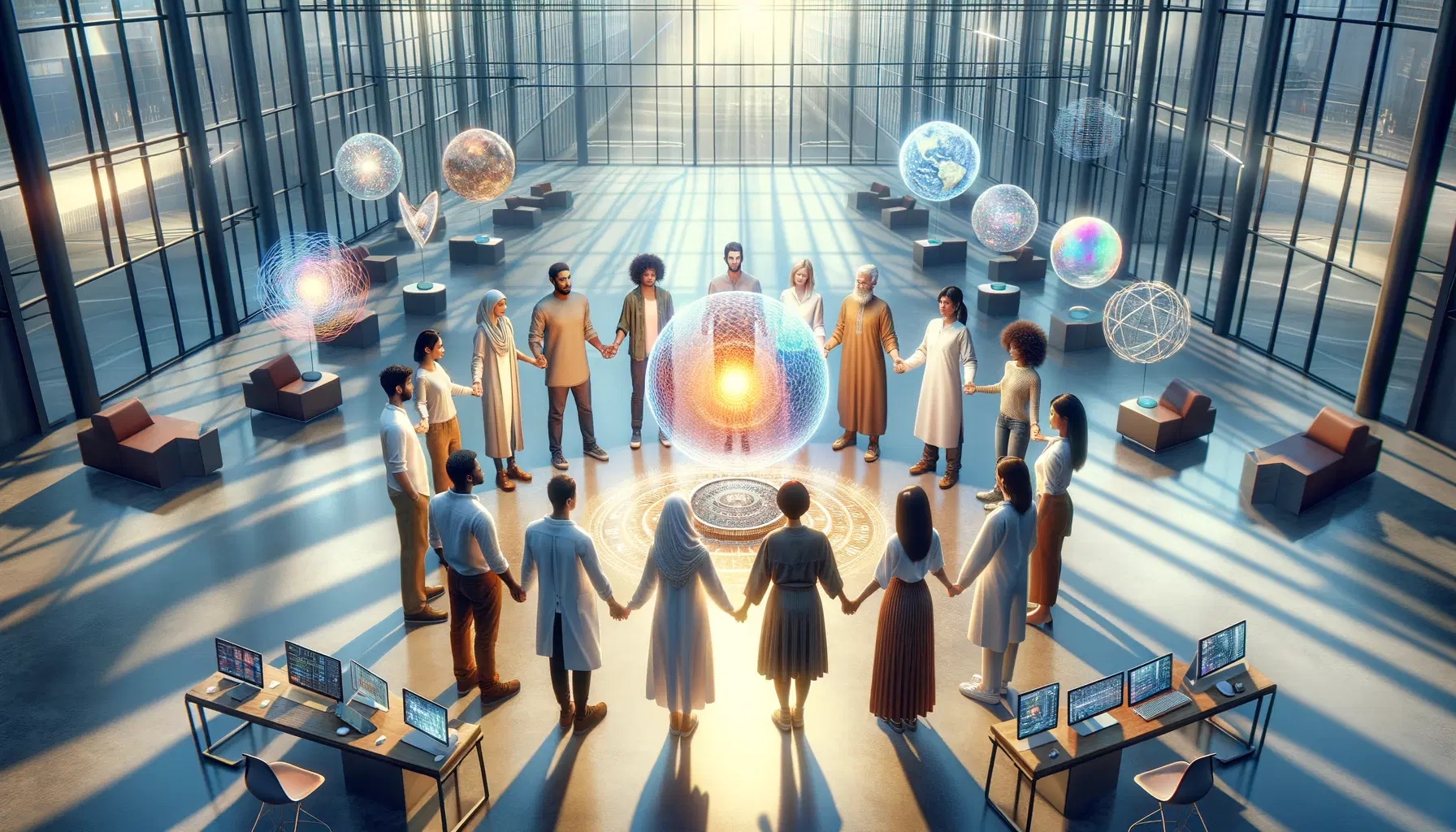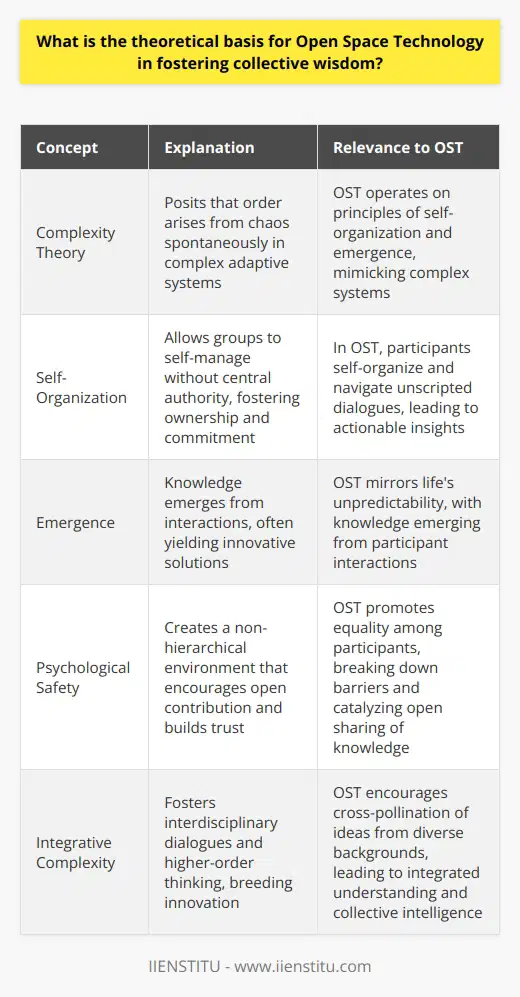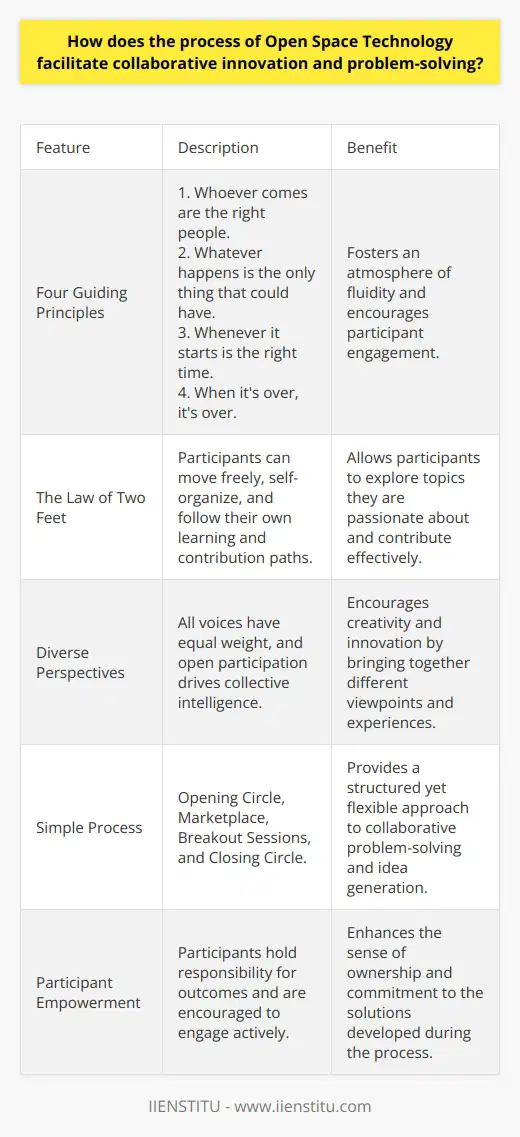
Open Space Technology (OST) is an innovative approach to organizing and facilitating group discussions with the aim of addressing complex and critical issues, fostering collective wisdom, and catalyzing effective action. Conceived by Harrison Owen in the mid-1980s, OST overturns conventional meeting formats, instead of relying on the self-organizing capacity of groups. Central to its methodology are the core principles that emphasize spontaneity, connection, and a philosophy that the right people with the necessary passion and responsibility will be present to serve the group's purpose.
In today’s fast-paced and interconnected world, OST’s relevance cannot be overstated. Transformative and collaborative working environments demand methodologies that not only adapt to change but also harness it as a resource for innovation and problem-solving. This blog delves into the nuances of OST and how it serves as a conduit for unleashing collective wisdom within diverse groups and settings.
As we embark on this exploration, readers will gain a deeper understanding of how OST facilitates dynamic conversations, nurtures group dynamics, and aligns energies toward constructive and creative outcomes. The following sections will go further in-depth, revealing the mechanisms that make this possible, and providing insights into how to best leverage OST in various contexts.
Understanding Collective Wisdom
Collective wisdom is the emergent property of shared knowledge, insights, and intuition, typical of well-synchronized groups. It goes beyond the sum of individual contributions, encapsulating a higher level of thinking that emerges from the synergy of the collective. This phenomenon is rooted in the belief that groups possess an inherent capability to converge on innovative solutions and deep insights that would be unattainable to individuals alone.
In the sphere of problem-solving and innovation, collective wisdom represents a critical resource. The ability to tap into the collective intellect and experience of a group can lead to robust decision-making and breakthrough ideas. This resource is particularly beneficial in disciplines like complex system analysis, organizational development, and community engagement, where the confluence of varied perspectives is vital.
To illustrate the power of collective wisdom, consider the myriad instances where collaborative endeavors have led to pioneering advancements. From scientific research teams making groundbreaking discoveries to cross-sector coalitions addressing social challenges, the thread that unites these successes is the effective harnessing of collective wisdom. These examples serve as a testament to the potential that lies in structured collaborative approaches like OST.
The Mechanics of Open Space Technology
Key Components of OST
At its heart, OST consists of key structural elements that guide the process toward success. The first is the Circle Arrangement, providing an egalitarian setting where every participant has an equal opportunity to contribute. Next is the Bulletin Board, which acts as a repository for topics and ideas generated by the participants themselves, emphasizing the self-directed nature of the OST process. Lastly, the Marketplace is a dynamic space where information and ideas flow, schedules are adjusted, and participants decide where to contribute their time and effort.
Root Cause Tree Analysis: Insights to Forensic Decision Making
Process Mapping: A Comprehensive Guide to Efficient Workflow Management
The Role of the Facilitator
The facilitator in an OST session holds a distinct role compared to traditional meeting moderators. Rather than directing the conversation, they serve by creating and holding space for others to engage deeply with the matter at hand. They provide minimal interventions to keep the process within its philosophical bounds but afford maximum freedom to participants to navigate their own discourse. This finesse ensures that participants own the process, and in doing so, uphold the authenticity and integrity of the collective wisdom that emerges.
Setting the Agenda Collaboratively
In OST, the agenda setting is a collective, real-time process led by the participants themselves, which stands in stark contrast to pre-determined conference schedules. This unconference approach invites spontaneity and encourages individuals to propose sessions around topics for which they hold a genuine passion. The inclusive and dynamic nature of this process ensures a sense of ownership and engagement among all attendees, setting the stage for authentic and productive collaboration.
Unleashing Potential and Fostering Collaborative Innovation
Creating an environment that nurtures potential and innovation demands a deliberate and careful cultivation of openness and psychological safety. These aspects invite participants to share unconventional ideas and challenge the status quo without fear of ridicule or reprimand. Techniques such as encouraging questions, normalizing failure as a learning opportunity, and celebrating diverse viewpoints are critical in constructing such spaces.
Stories of OST sessions resulting in groundbreaking collaborative innovation abound. These narratives often begin with a diverse group of stakeholders sharing a common concern or goal. Through the OST process, a melting pot of ideas surfaces, from which clear patterns and actionable strategies commonly emerge. This process's magic lies not in strict planning but in the organic development of thought and consensus.
Maintaining the vitality of group dynamics post-event is both a challenge and an opportunity. Techniques like regular follow-up meetings, using collaborative platforms for continued dialogue, and setting shared goals are tools that groups can use to keep the momentum alive. Such strategies help in aligning the energies generated during OST sessions with long-term objectives and tangible outcomes.
Challenges and Considerations in Open Space Technology
Potential Pitfalls and How to Avoid Them
While OST offers many opportunities for harnessing collective intelligence, it is not without potential pitfalls. Discomfort with ambiguity or a lack of trust in the process can deter full participation. Moreover, discussions may veer off course without careful facilitation. To prevent these issues, facilitators must guide with a light yet firm hand and foster an environment where structure and freedom balance each other. This can often be achieved by consistently reinforcing the core principles and the law of OST.
Adapting OST for Various Contexts
OST is versatile enough to be modified for different group sizes, from a handful of participants to several hundred. However, care must be taken to maintain the integrity of the process across these varying scales. Additionally, with the rise of digital communication tools, OST has found new ground in virtual settings. Here, adapting the technology to mimic the fluidity and openness of physical spaces is crucial for maintaining the free-form exchange and the emergent nature of OST.
The Future of Open Space Technology
As we look ahead, the trajectory of OST seems intertwined with advancements in collaborative technologies and evolving cultural practices within organizations. As teams become more decentralized and complex, OST holds promise for serving as a binding force that brings coherence and direction. Incorporating artificial intelligence to assist in pattern recognition and data visualization during OST sessions may amplify the innate capabilities of groups to derive meaningful insights.
Recognition of the value of facilitated discussion in a corporate strategy, educational initiatives, and community engagement further solidifies OST's role in group innovation. In the future, as organizations seek to democratize their decision-making processes and ignite the latent potential within their ranks, OST will likely continue to grow in adoption and sophistication.
This exploration of Open Space Technology brings us to a greater appreciation of its unique capacity to unleash collective wisdom. By understanding and applying the principles and practices of OST, facilitators and participants alike can contribute to the co-creation of innovative solutions and nurturing collaboration. The true testament to its effectiveness lies in the stories of transformation and achievement that emanate from those who have experienced its power.
Groups and individuals seeking to harness collective wisdom and ignite collaborative innovation are encouraged to consider adopting OST. As we reflect on the insights and examples provided, it is clear there is a profound opportunity for both personal and collective growth in employing this methodology. Let this serve as a catalyst to explore the depths of OST in your own personal, professional, or organizational contexts.
The potential encoded within groups awaits to be unlocked; Open Space Technology presents a compelling key to that puzzle. With a mindset of openness, a spirit of inquiry, and a structure that fosters genuine dialogue, the future of collaborative work is vibrant and holds great promise for those willing to engage with it fully.
Frequently Asked Questions
What is the theoretical basis for Open Space Technology in fostering collective wisdom?
Open Space Technology (OST) draws from complex systems theory. It acknowledges that high levels of complexity require adaptive processes. Knowledge emerges from the interaction of diverse agents. OST sets the stage for these interactions.
Complexity Theory
OST operates on principles of self-organization and emergence. Complexity theory posits that order arises from chaos spontaneously. In an OST event, participants self-organize. They navigate the territory of unscripted dialogues. This mimics complex adaptive systems found in nature.
Self-Organization
OST allows groups to self-manage. No central authority directs conversations. Participants move fluidly between discussions. Ideas coalesce naturally. Self-organization fosters ownership. Ownership bolsters commitment. Commitment transforms into actionable insights. These are the seeds of collective wisdom.
Emergence
Knowledge in OST emerges. It is not pre-determined. Participants bring individual insights to the group. Group dialogues synthesize these insights. The synthesis often yields innovative solutions. The emergent nature of OST mirrors life’s unpredictability.
Psychological Safety
OST hinges on creating a space of psychological safety.
Non-hierarchical Environment
OST promotes equality among participants. Everyone's voice holds equal weight. This non-hierarchical stance encourages open contribution. It breaks down barriers. It builds trust. Trust catalyzes open sharing of knowledge.
Openness and Autonomy
OST emphasizes free expression. Participants choose what to discuss. They also decide how to engage. This autonomy supports authenticity. Authentic dialogues uncover deep insights. These insights form the crux of collective wisdom.
The Law of Two Feet
The OST principle, the Law of Two Feet, empowers action. It gives participants the right to move. If one is neither learning nor contributing, they walk away. This ensures engaged participation. Engaged participants foster richer, more productive discussions.
Personal Responsibility
Personal responsibility underpins the Law of Two Feet. Participants hold themselves accountable. They engage where they can contribute most. This responsibility enhances the quality of the shared knowledge base.
Engagement and Flow
When people engage where their passion lies, flow states emerge. Flow states are peak performance states. They facilitate deep work and innovation. Engaged participants are more likely to reach these states. This augments the collective cognitive prowess.
Open Space and Democracy
OST has democratic underpinnings.
Inclusivity
Inclusion is key in OST. All perspectives get a hearing. Every idea receives consideration. Diversity enriches the process. It brings a multiplicity of viewpoints. This diversity is a wellspring of collective wisdom.
Collective Decision-making
Decisions in OST arise from the collective. They are not top-down. They sprout from the ground up. This democratic approach taps into the collective intellect and experience. It enables solutions that resonate on a broader scale.
Integrative Complexity
OST fosters integrative complexity.
Interdisciplinary Dialogues
OST encourages cross-pollination of ideas. Participants from varied backgrounds converge. They share, debate, and refine ideas. The result is an integrated understanding that spans disciplines. This integration breeds innovation.
Higher-order Thinking
OST pushes participants toward higher-order thinking. As disparate ideas collide, new patterns form. These patterns represent higher levels of analysis and synthesis. This is the crucible of collective intelligence.
Open Space Technology is more than a mere meeting format. It embodies principles that tap into human dynamics. It leverages self-organization, emergence, and inclusivity. OST provides the framework for harnessing the wisdom inherent in groups. It does so by replicating the organic, democratic, and integrated processes of thriving systems. This is the theoretical bedrock on which it stands. It is why OST can be a powerful tool for fostering collective wisdom in any group.

How does the process of Open Space Technology facilitate collaborative innovation and problem-solving?
Open Space Technology: A Collaborative Powerhouse
Origin and Overview
Open Space Technology (OST) began in the mid-1980s. Harrison Owen, its creator, noticed an interesting pattern. People often found coffee breaks the most useful part of formal conferences. Owen sought to harness this informal, conversational power. OST facilitates large group dialogue. The focus lies on interaction and problem-solving.
Key Principles
OST operates on four guiding principles:
1. Whoever comes are the right people.
2. Whatever happens is the only thing that could have.
3. Whenever it starts is the right time.
4. When it's over, it's over.
These principles foster an atmosphere of fluidity. They encourage participant engagement.
The Law of Two Feet
A core tenet of OST is the Law of Two Feet. Participants can move freely. They self-organize. They follow their own learning and contribution paths.
Setting the Stage for Innovation
OST sets the stage for innovation. It does so by inviting diverse perspectives. All voices have equal weight. This open participation drives collective intelligence. Discussants freely explore new avenues. Creativity flourishes in such a democratic space.
The Process
OST embraces a simple yet effective process.
- Opening Circle: OST begins here. The facilitator explains the process. Agenda items come from the participants. Everyone has a say.
- Marketplace: Participants post issues they care to discuss. A grid or wall displays topics. Attendees sign up, showing their interest.
- Breakout Sessions: Groups disperse across various sessions. They engage deeply with chosen topics. True collaboration takes form here.
- Closing Circle: Everyone reconvenes. They share insights and next steps. Reflection and summary are key. This may lead to actionable outcomes.
Benefits of OST
OST benefits collaborative effort in various ways:
- It maximizes participant engagement.
- Diverse ideas gain a platform.
- A sense of community strengthens.
- It identifies actionable initiatives quickly.
- Participants hold responsibility for outcomes.
Challenges and Considerations
Despite its strengths, OST brings challenges. Facilitators must manage ambiguity. They support the process without controlling the content. Participants must embrace uncertainty. They must be willing to engage and self-manage.
OST in Action
Many fields use OST effectively. These include technology, education, and community development. They report enhanced innovation. They note improved problem-solving. Their successes underscore OST's potential.
Open Space Technology reimagines meetings and conferences. It underpins collaborative innovation. It does so by empowering participants. Engagement and responsibility define the process. The result? Shared ideas transform into shared solutions.

In what specific ways can Open Space Technology be utilized for effective organizational management?
Understanding Open Space Technology
Open Space Technology (OST) provides a framework. It fosters self-organization. This can be crucial in managing organizations effectively. OST embraces complexity and diversity. It allows for multiple issues to be explored simultaneously.
OST for Strategic Planning
Organizations use OST for strategic planning. They value input from different levels. OST sessions encourage unfettered dialogue. Diverse perspectives can surface during these sessions. This ensures that planning considers multiple viewpoints. It aids in crafting a robust strategy.
Tackling Complex Issues
OST excels with complexity. It can help dissect intricate problems. Participants lead the conversation forward. They explore multifaceted aspects of organizational challenges. These conversations can spawn innovative solutions. They often illuminate previously unseen pathways.
Enhancing Employee Engagement
Employee engagement often surges during OST events. The methodology promotes ownership. Participants decide the discussion agenda. This empowerment boosts their commitment. They feel valued. Their engagement correlates with higher performance. This can positively impact overall management effectiveness.
Encouraging Cross-Functional Collaboration
OST breaks down silos. It allows different departments to interact freely. Cross-functional teamwork emerges naturally. This collaboration can yield synergistic effects. Organizations become more adept at managing internal resources. Collaboration contributes to a cohesive workplace culture.
Fostering a Culture of Openness
Open communication is key in OST. A culture of openness develops as a result. Management and staff interact without hierarchy. This openness can build trust. Trust enhances organizational functioning. It serves as a foundation for strong management practices.
Supporting Leadership Development
OST also aids in developing leaders. Participants often show leadership during discussions. They take responsibility for topics they care about. These experiences can hone their leadership skills. They prepare employees for future management roles.
Adapting to Change
Change management benefits from OST. The method suits ad hoc meetings. It also fits regularly scheduled sessions. Participants learn to navigate change together. The collective adaptability strengthens the organization. It prepares them for unforeseen shifts.
Improving Conflict Resolution
Conflict resolution is another area of use. OST creates a safe space for airing grievances. It enables problem-solving through dialogue. Participants address tensions constructively. This can ease conflicts. It fosters understanding and mutual respect.
Cultivating Innovation
Innovation thrives in open environments. OST provides such an environment. It invites imaginative thinking. Participants propose and explore new ideas. Many organizations rely on this for creativity. It leads to continuous improvement.
Implementing Organizational Learning
Learning is continuous in OST settings. Participants share knowledge freely. Best practices emerge. Insights from these sessions influence policies. Organizations learn and grow collectively. They manage more wisely as a result.
OST offers numerous benefits for organizational management. It encourages flexibility, communication, and collaboration. These aspects are vital for successful contemporary management. Adapting OST enhances corporate culture. It produces strong, agile, and innovative organizations.



